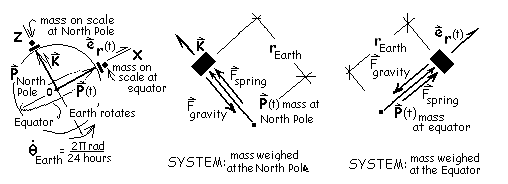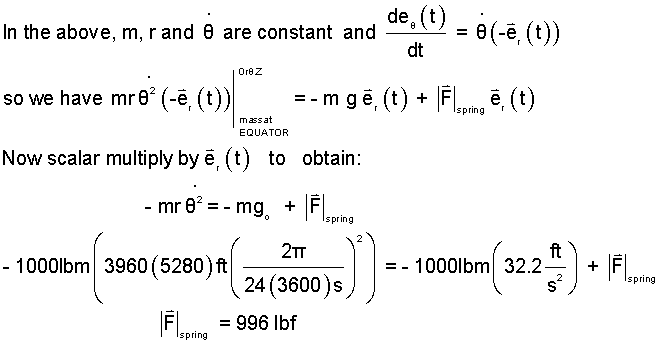| THERMO Spoken Here! ~ J. Pohl © ( A9840~3/15) | ( A9842 - Kinematics of Bar AB) |
Polar Versus Equatorial Weight
Suppose we have a certified mass of 1,000 pounds. Demonstrate analytically that by measurement of a spring scale, the mass will weigh 1,000 pounds force at the North Pole but only 996 pounds force at the equator? (Ignore the buoyant effect of atmospheric air).
♦ Newton's Second Law will be applied. In each case the system is the thousand pound mass. The forces acting will be gravity and the support force (of the spring) of a scale. Our inertial reference has the center of Earth as the origin. This means we assume the center of Earth to move in a straight line at a constant speed. The vector triad, er(t), eθ(t) and K will be used. Imagine the mass to rest on a spring scale at the North Pole and later at the Equator.
Sketches depicting the two measurements of weight are combined in one drawing below:

Calculation: Scale Reading at the North Pole: Newton's Second Law will tell us that number. The sketch (above center) shows the mass (on a scale position vector (center sketch) of the mass initiates at the center of Earth and extends the Earth radius, r, then a short distance further to arrive at bottom of the mass on the scale. Physically the mass contact with the scale as it (and the scale), rotate or pivot at that point on the Earth axis.
A super-precise answer is not needed; assume the radius of Earth as 3960 miles and the surface acceleration of gravity there to be 32.2 ft/s2. For this application, the forces of Newton's Second Law are gravity (at the Pole) and the supporting spring force of the scale. The equation is written as:
 |
(1) 1 |
For the weighing at the equator, the mass and scale supporting and the place where it rests are rotating with Earth. The position vector of the mass and scale rotates about Earth's center. So we differentiate position correctly as follows:
 |
(2) 2 |  |
(3) 3 |
Now enter there results into Newton's Second Law:
 |
(4) 4 |
 |
(5) 5 |
A gravity force will act on the mass on the spring scale whether at the North Pole or equator. At the North Pole the mass has no component of momentum relative to the Earth center. The K-axis is directed vertical from the weighing place at either pole. The mass and scale just pivot or rotate about the axis vertically through them. Locations on Earth's equator are not inertial. The mass there has momentum; to weigh a mass there will incur a small error.
Polar Versus Equatorial Weight
Suppose we have a certified mass of 1,000 pounds. Demonstrate analytically that the mass will weigh 1,000 pounds force at the North Pole but only 996 pounds force at the equator? (Ignore the buoyant effect of atmospheric air).
Premise presently unwritted!